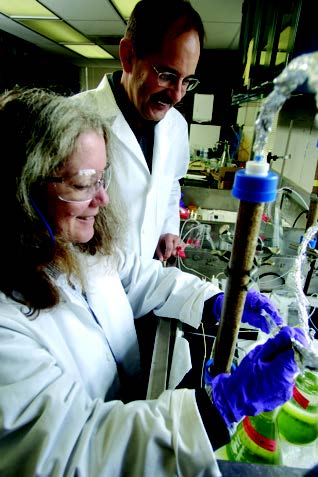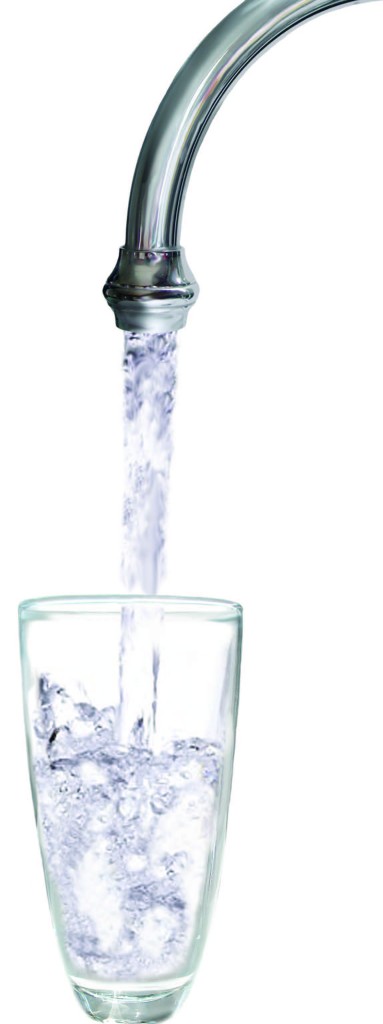In their hunt for emerging contaminants in the water supply, A. Lynn Roberts and Edward J. Bouwer probe beyond the usual suspects.

WITH ABOUT 80,000 CHEMICALS being produced in the United States, even the most diligent environmental watchdogs have to prioritize the list of pollutants to be monitored and regulated. In the 1970s, when the U.S. Environmental Protection Agency (EPA) created a list of 129 “priority pollutants,” it was the result of an extensive screening process. What chemicals were most toxic? Which were most common? Which were most likely to concentrate? How do they move through the environment?
The criteria made sense, but there was one other deciding factor that must now be revisited, according to A. Lynn Roberts, professor in the Whiting School of Engineering’s Department of Geography and Environmental Engineering (DoGEE): “We should have recognized that advances in environmental chemistry tend to be driven by advances in analytical instrumentation.” Her point is that the EPA didn’t put a chemical on the list if scientists didn’t know how to measure it, and their capabilities 30 years ago were much more limited than they are today.
“The techniques for environmental analysis are very powerful now,” Roberts says, “with phenomenal sensitivity down to a fraction of a nanogram in a liter of water. But you have to key in on a specific compound. If you’re not looking for something, you won’t see it.”
That’s why a group headed by Roberts and fellow DoGEE professor Edward J. Bouwer is looking at what are known as “emerging contaminants.” These are substances that now can be detected and monitored and may deserve serious attention from the scientific and regulatory communities. With advanced instrumentation at their disposal, they are ferreting out those chemical pollutants that previously slipped under the radar. As Bouwer says, “A lot of the easy questions have been answered. Now we’re looking at compounds that are more complex, more esoteric.”
In a project funded by the international Awwa Research Foundation, Michelle Hladik ’06 PhD, as a graduate student in the Roberts Lab research group, applied some “chemical intuition” to come up with 20 compounds she thought were likely to be present in the water supply. Testing water from facilities in the Midwest, she detected 19 of the 20 chemicals. Testing waters from the Chesapeake Bay, she again found 19 of the 20. Her study indicated that conventional water-treatment techniques are not efficient at removing these pollutants. In one instance, Hladik found that while a particular herbicide was successfully broken down by chlorination, the process created a degradation product that was potentially even more dangerous that the herbicide itself. Says Roberts about such emerging concerns, “We’re just transmuting the problem, lulling people into a false sense of security.”
“A lot of the easy questions have been answered. Now we’re looking at compounds that are more complex, more esoteric.”Edward J. Bouwer

Roberts and Bouwer also are investigating a range of other possible sources of emerging pollutants that could not be measured in the 1970s, sometimes simply because they didn’t yet exist. They include pharmaceuticals, personal care products, and antiseptics. Some deserve attention because we used to think they were broken down in sewage treatment plants when, in fact, they are not. Others, we now realize, accumulate very quickly. Still others have become abundant as micropollutants because of the high volume of drugs consumed in this country.
With help from graduate students Kevin Bisceglia and Jim Yu, Roberts and Bouwer are conducting extensive studies of pharmaceuticals. They are reviewing the top 200 prescribed drugs, the top 200 over-the-counter drugs, the top 200 generics, and so on. “We have now done sampling in some sewage treatment plants along the Northeast coast,” says Bouwer. “Many of the target pharmaceutical compounds are being removed partially but still are coming out in the effluents. We have also done parallel laboratory studies that mimic field conditions so we can do tests on a small scale at low cost and under controlled conditions.” By discovering the fate of these chemicals and publishing the results, Bouwer and Roberts will help determine if any of the compounds belong on the EPA’s Candidate Contaminant List.
In a society that constantly generates new substances that may pose environmental or health risks, these DoGEE researchers will have plenty to keep them busy. As Roberts says, “We just keep handing Pandora new boxes, and she just keeps opening them.”
To learn more about the work of A. Lynn Roberts and Edward J. Bouwer, visit engineering.jhu.edu/~dogee.




